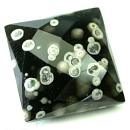|
|
||||||||||||||||
|
||||||||||||||||
|
||||||
|
|
|
|
Cristobalite
(inclusions
in Obsidian) |
|
| | |
| Discovered in 1887; IMA status: Valid (pre-IMA; Grandfathered) | ||
|
| ||
|
Chemistry |
|
|
| |
|
SiO2 | |
|
|
Silicon Dioxide |
|
Molecular Weight: |
60.08 gm |
|
Composition: |
Silicon |
46.74 % |
Si |
100.00 % |
SiO2 |
|
|
Oxygen |
53.26 % |
O |
|
|
|
|
|
100.00 % |
|
100.00 % |
= TOTAL OXIDE |
|
|
|
||||
|
Classification |
|
|
| |
|
Oxides | |
|
4/D.01-30 | |
|
|
4 : OXIDES (Hydroxides, V[5,6] vanadates, arsenites, antimonites, bismuthites, sulfites, selenites, tellurites, iodates)
|
|
Related to: |
Polymorph of Quartz, Tridymite, Coesite and Stishovite. |
|
Varieties: |
None |
|
Synonyms: |
Cosmic Obsidian, a-Cristobalite, b-Cristobalite, Low Cristobalite, Lussatine |
|
|
|
|
Crystal Data |
|
|
|
|
|
As pseudo-octahedral crystals, to 4 mm, with {110} and {331}, rarely pseudocubic. Commonly dendritic to skeletal; as spherulites to several cm; fibrous or microcrystalline ("opal"), massive. |
|
|
On {111}, common, interpenetrant, polysynthetic, repeated. |
|
|
|
|
|
Physical Properties |
|
|
|
|
|
None |
|
|
Irregular/Uneven |
|
|
Brittle |
|
|
6.0 - 7.0 |
|
|
2.32 - 2.36 (g/cm3) |
|
|
Fluorescent; LW UV = Green Red; LW UV = Green Red |
|
|
Not Radioactive |
|
|
Other: |
Thermal properties: inverts from high- or ß-Cristobalite at 286°C or below |
|
|
|
|
Optical Properties |
|
|
|
|
|
Colorless, White, milky White to Yellowish, Blue-Gray, Gray; Colorless in transmitted light. |
|
|
Transparent to Translucent |
|
|
Vitreous |
|
|
1.484 - 1.487 Uniaxial ( - ) |
|
|
0.003 |
|
|
None |
|
|
None |
|
|
|
|
|
Occurances |
|
|
|
|
|
Geological Setting: |
In vesicles and lithophysae; a late-crystallizing phase in basaltic to rhyolitic volcanic rocks; from acid-sulfate-type hydrothermal alteration of volcanic rocks; precipitated by hot springs. By contact metamorphism of sandstone; developed during diagenesis, recrystallized from siliceous sedimentary rocks. |
|
Common Associations: |
Alunite, Anorthoclase, Fayalite, Kaolinite, Magnetite, Opal, Quartz, Sanidine, Tridymite |
|
Common Impurities: |
Fe, Ca, Al, K, Na, Ti, Mn, Mg, P |
|
Type Locality: |
Cerro San Cristóbal, Mun. de Pachuca, Hidalgo, Mexico |
|
Year Discovered: |
1887 |
|
View mineral photos: | |
|
|
|
|
More Information |
|
|
|
|
|
| |
|
|
|
|
Notable occurrences include the
type locality of Cerro San Cristóbal, Mun. de Pachuca, Hidalgo, Mexico; Eifel
District, Germany; the Ellora Caves, Maharashtra, India;
Lipari Island, Messina Province, Sicily, Italy; Goroyama, Japan; about 150 km north of Auckland, New
Zealand; in the USA in the San Juan Mountains, San Juan County,
Colorado; Coso Hot Springs, Inyo County, California;
near Crater Lake, Klamath County, Oregon; and many other
locations. |
|
|
We
have not photographed our Cristobalite gems. Please
check back soon. |
